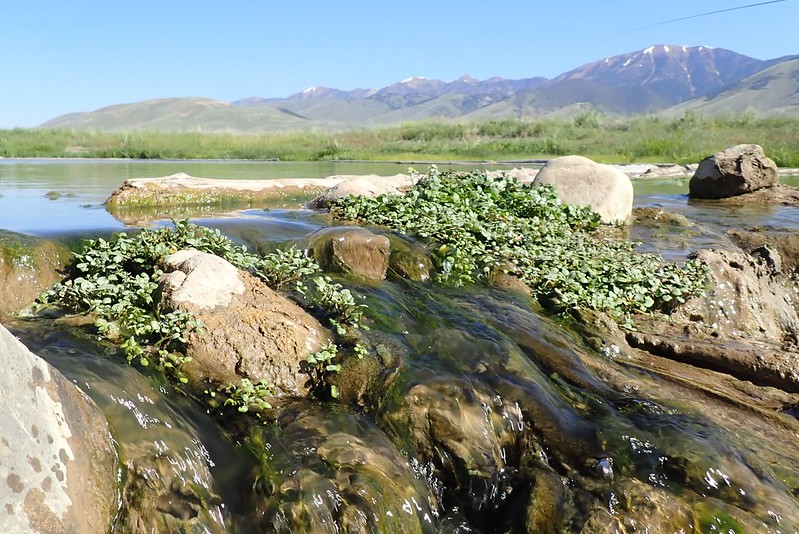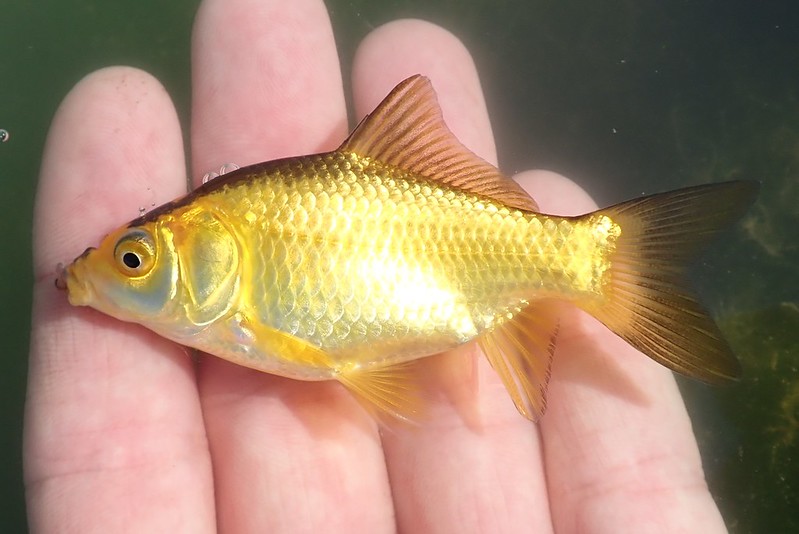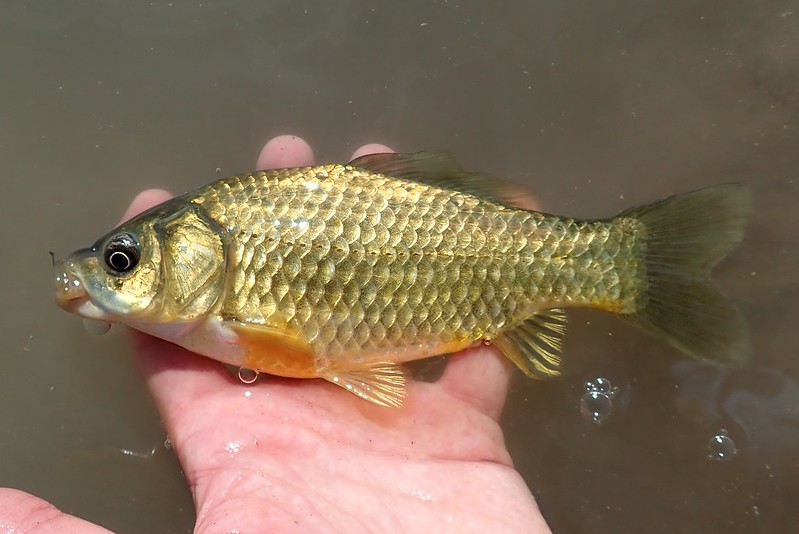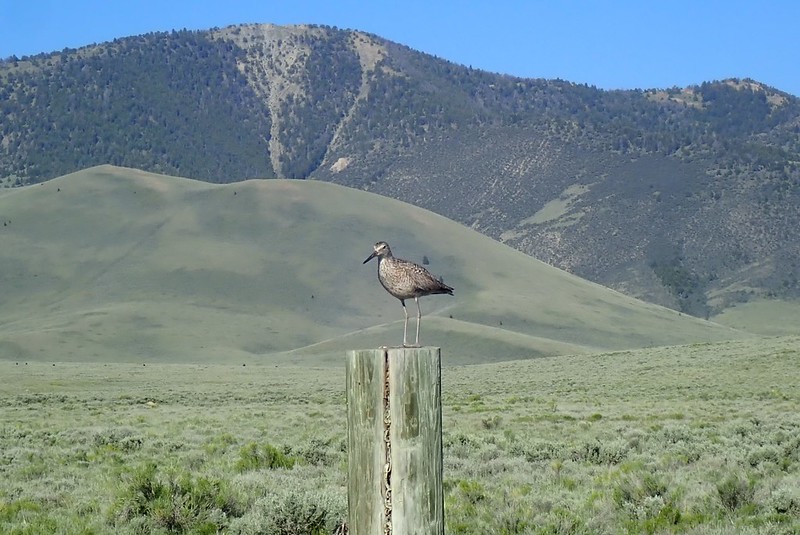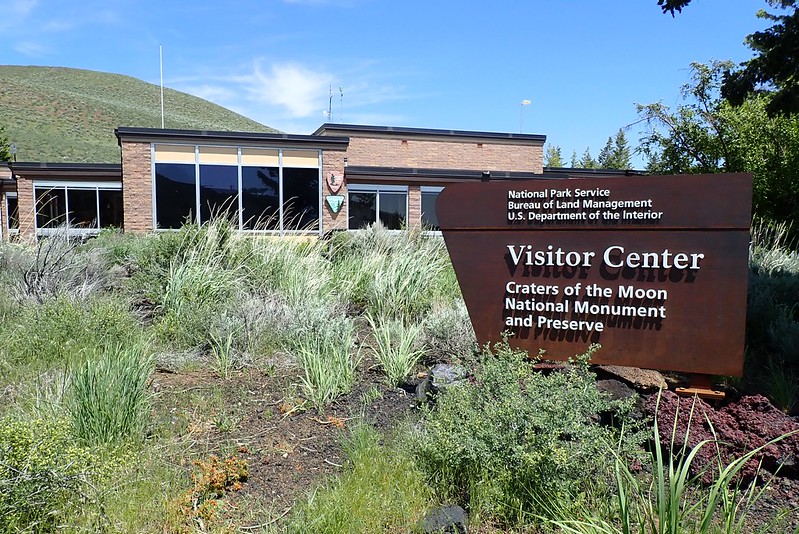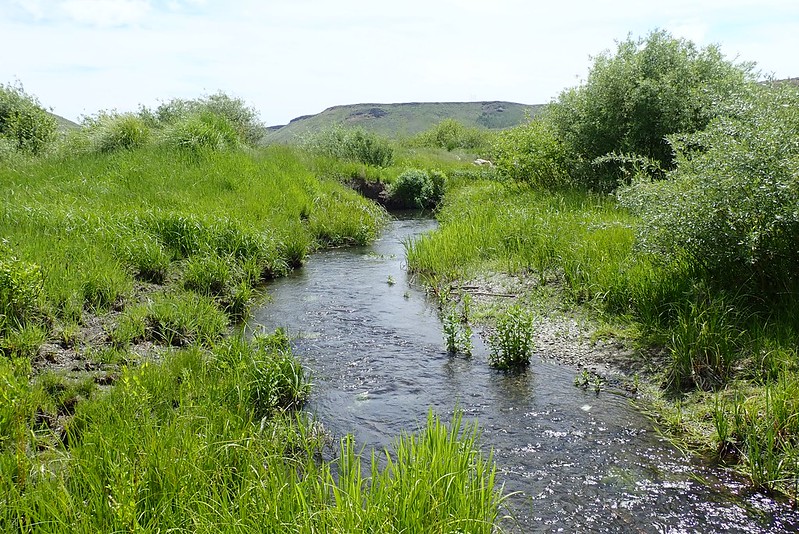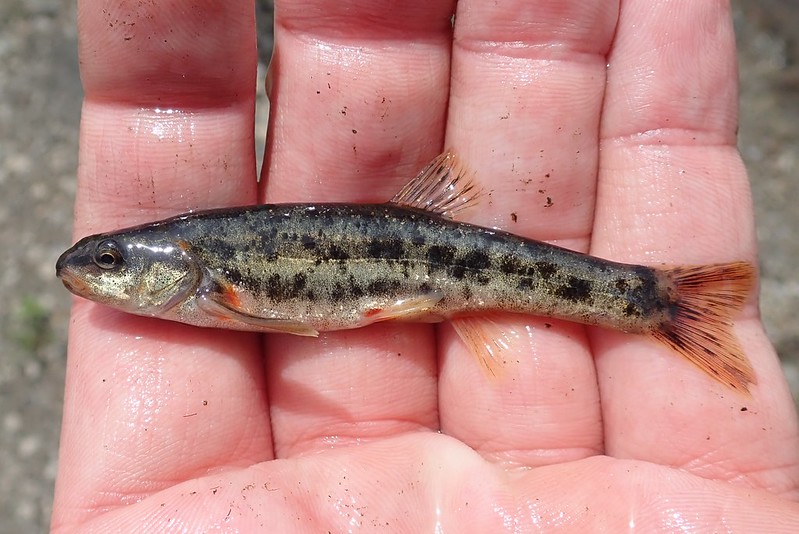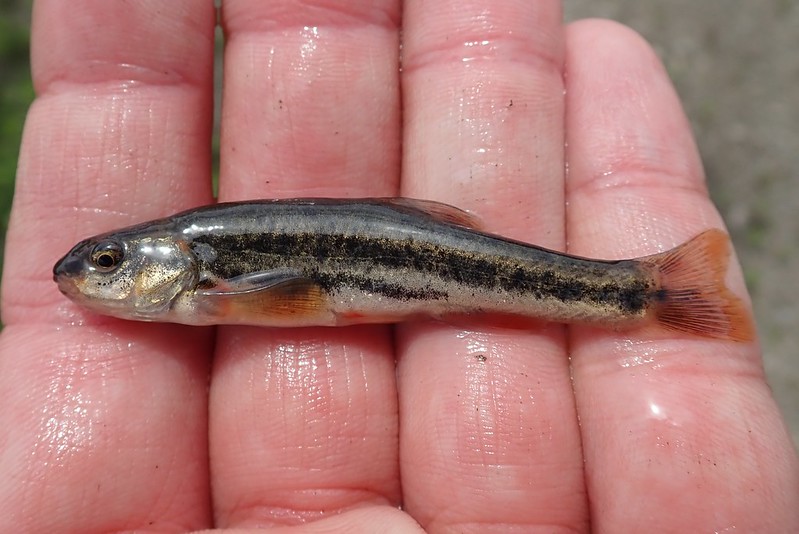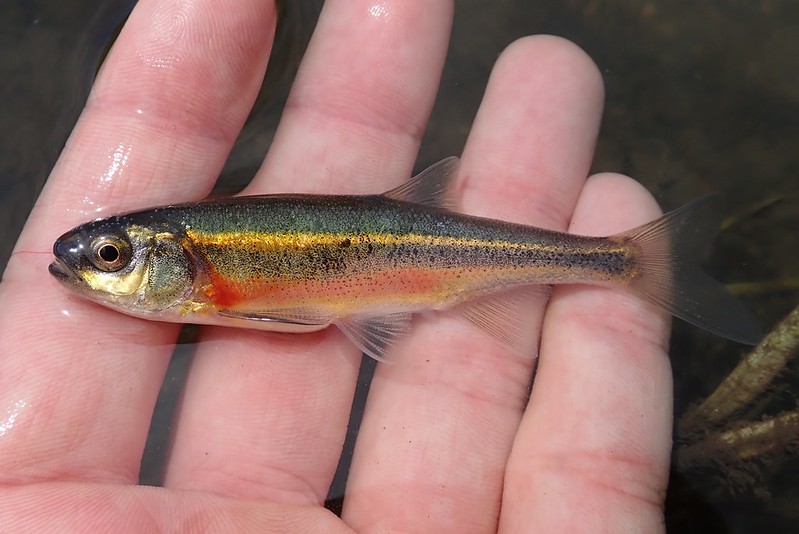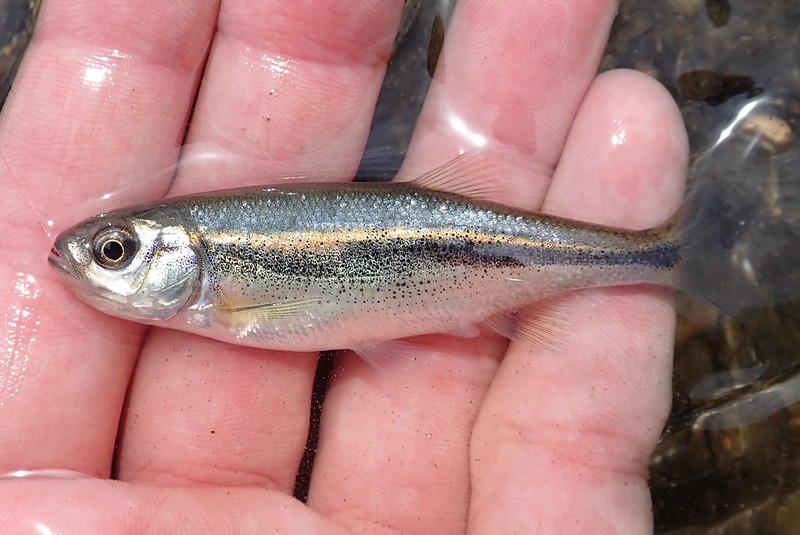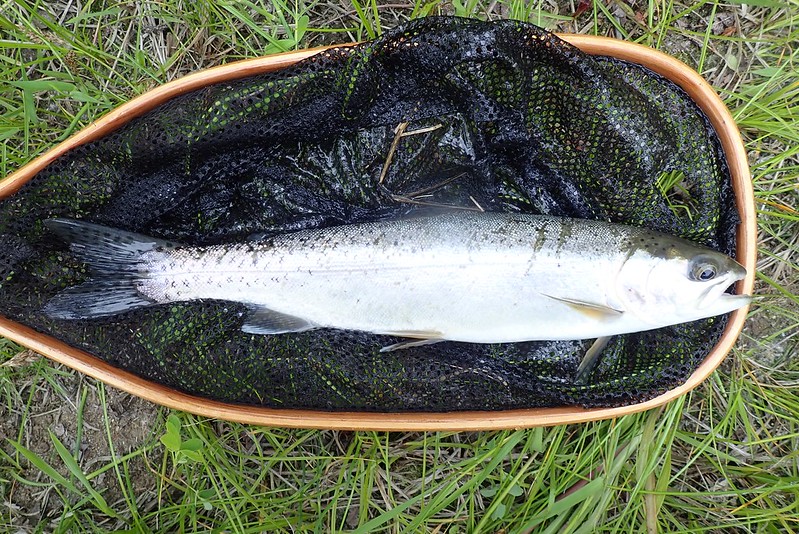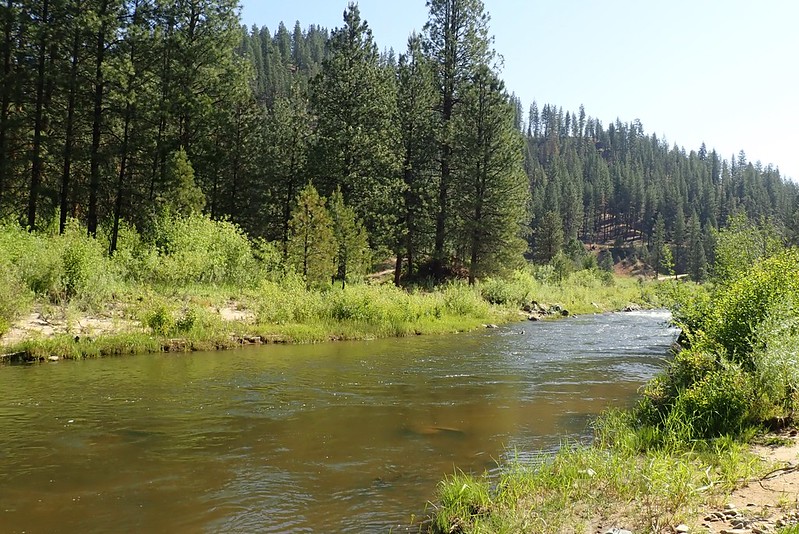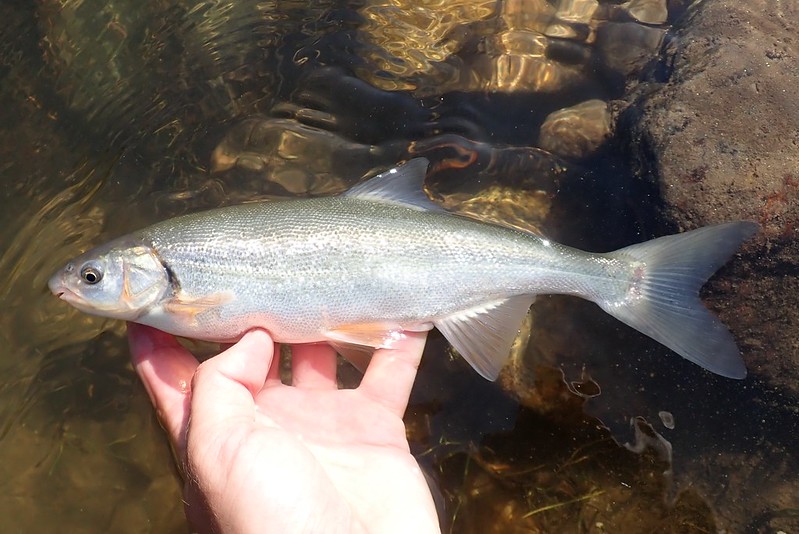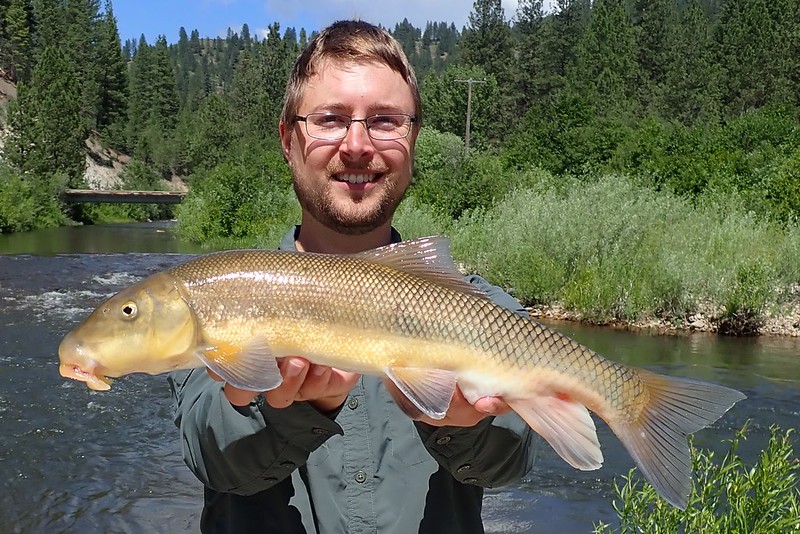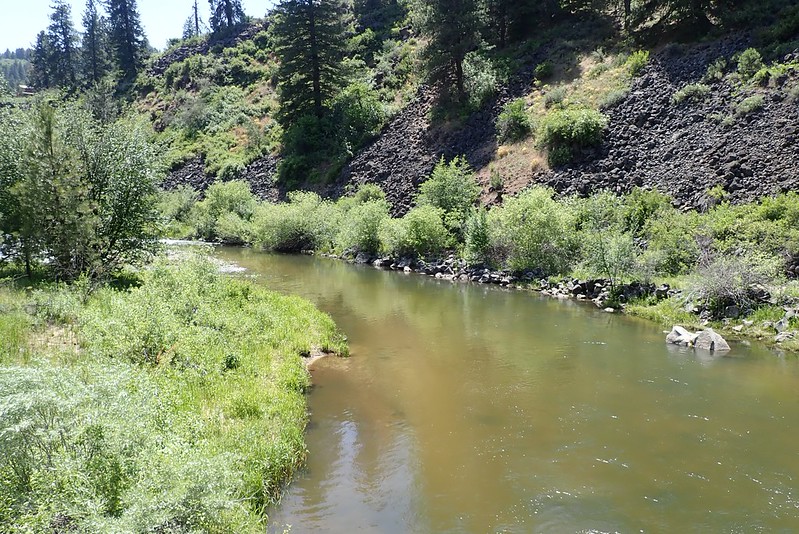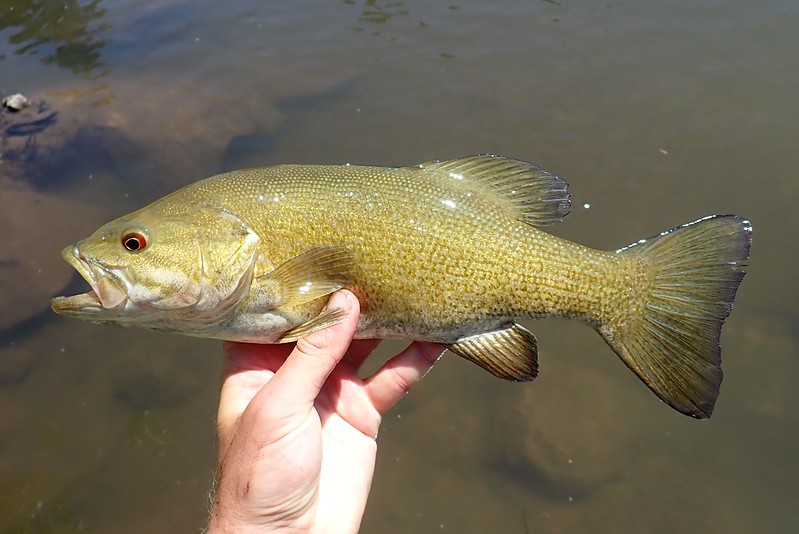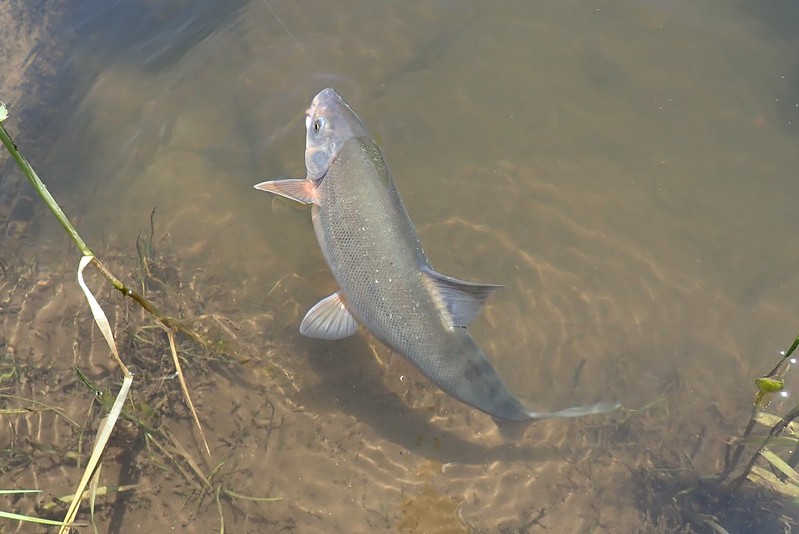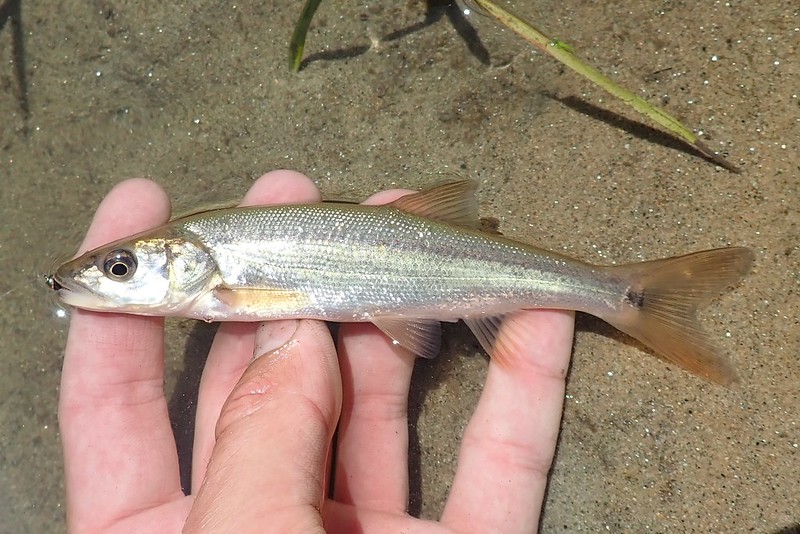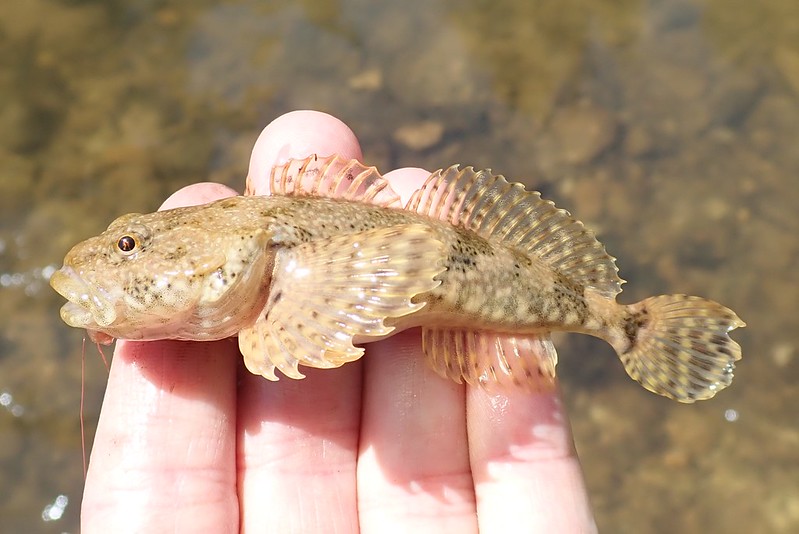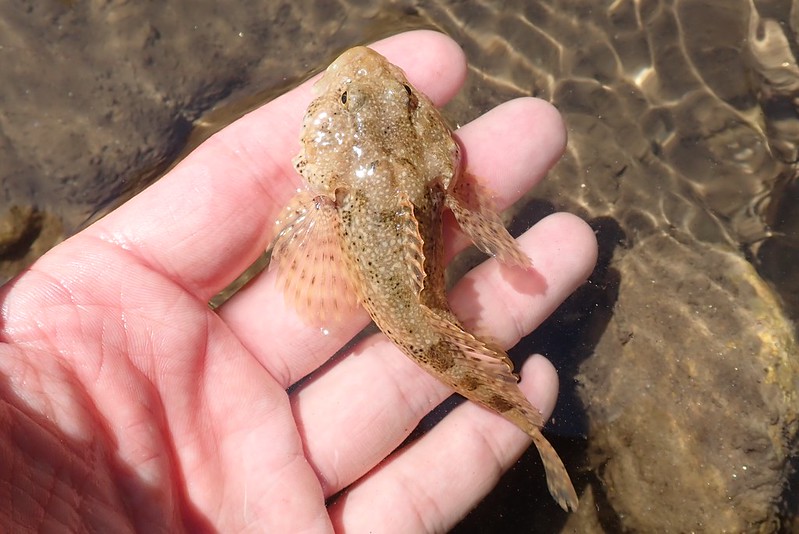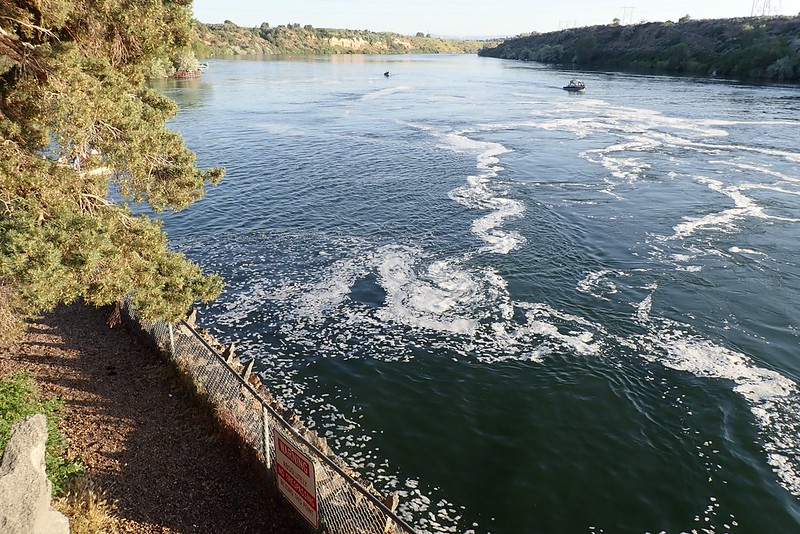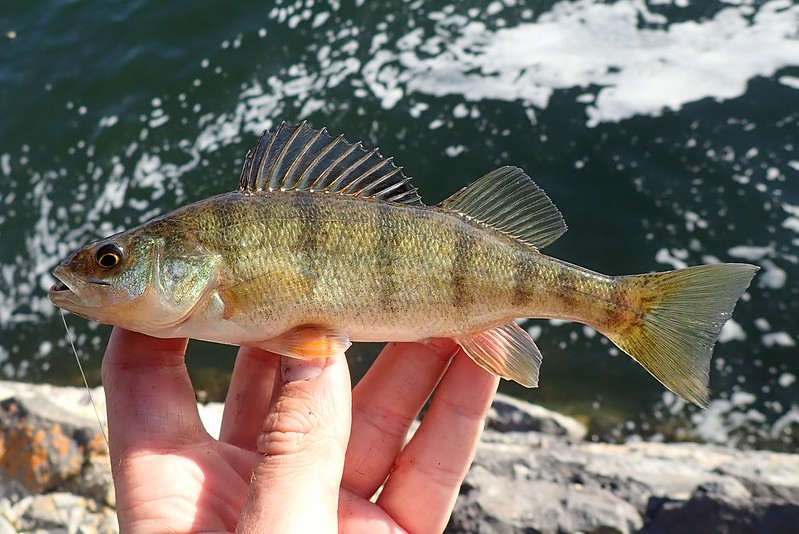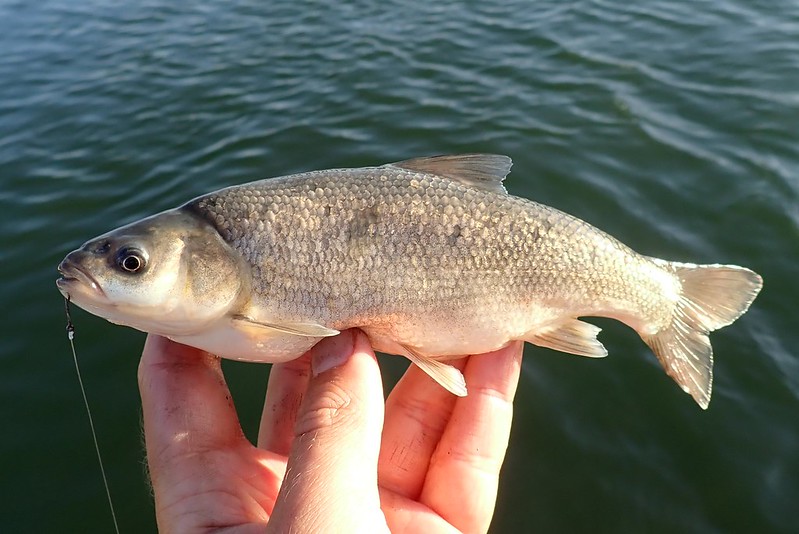We woke up the next day in the town of Blackfoot and ventured north to Barney Hot Springs. Matt has brought several of our mutual friends to this spot in the past. Despite its remoteness, the drive is worthwhile because you can catch an interesting variety of tropical aquarium fish such as Mozambique tilapia, convict cichlid, zebra mbuna, and green swordtail.
However, Matt was dismayed when we pulled up to the spring-fed pond and saw that it was murky brown and choked with algae. He said the water should be clear and blue, so something must be wrong. We walked around the pond trying to understand what had happened. There were a few signs of life, so we got out our microfishing gear to see if we could still catch something.
Eventually I pulled up a small goldfish. We were relieved that the pond wasn't completely dead.
Goldfish (Carassius auratus)
Matt and I quickly began to suspect that goldfish were the only species living in the pond. Most of them had reverted to their natural wild color, but a few still had yellow or orange.
I had left one rod in a rod holder with a bait sitting in the center of the pond. It got one a hit, which turned out to be the biggest goldfish of the day. As we were packing up to leave, two graduate students showed up with sampling gear. They confirmed our fears - a flash flood during the previous winter had wiped out all of the warm-water tropical species. The goldfish were the only survivors.
There was nothing we could do but continue on our journey. We headed west, discussing other fishing opportunities in Idaho such as grayling up in the mountains. The scenery was great, and there was lots of wildlife to stop and see such as this willet standing on a fence post.
I was very excited to see my first pronghorn in the wild. We even saw a pair of adults with a group of young. My photos really don't do them justice.
The drive west was long, so we broke it up by stopping briefly at the Craters of the Moon National Monument and Preserve.
All around us was left over lava from a long extinct volcano. It was a really unique landscape.
Finally we arrived at our destination, a small stream in the Big Wood River drainage. It flowed through land with public access which we were happy to take advantage of.
Our primary target for this stream was bridgelip sucker, but we had trouble finding them. There weren't many pools, and even fewer that seemed deep enough to hold suckers. To pass the time as we hunted, I microfished to see if I could find anything else new. The fish near the riffles seemed to all be speckled dace.
Speckled Dace (Rhinichthys osculus)
The dace were quite variable with their patterns, but I'm pretty sure they were all the same species.
The deeper, slower pools had redside shiners in them, which were a new species for me. After a few drab colored ones I pulled up a beautifully colored male!
Redside Shiner (Richardsonius balteatus) - new hook & line species #554
Here's one of the larger females I caught for comparison.
We moved further downstream hoping to find better sucker habitat, but it was more of the same. I did spot several Wood River sculpin, a protected species in Idaho. It was neat seeing them, but I resisted the urge to microfish one for my list.
Wood River Sculpin (Cottus leiopomus)
Our last spot for the day was the South Fork Boise River. It contains bull trout, which would be the catch of a lifetime, but we were mostly focused on mountain whitefish.
Unfortunately the water was high and made fishing difficult. Matt instructed me to fish a bead-head nymph under a float, so that's what I did. The current was so strong that you had to reel in and reset just a few seconds after each cast.
Further downstream I switched to a small Kastmaster with the barb crimped down. I caught one rainbow trout, and had a few follows from others, but no mountain whitefish.
Rainbow Trout (Oncorhynchus mykiss)
It was a tough day being in a new state and getting only one new species on the second day. However, I think Matt and I both learned a lot, and we have some ideas of what to do differently next time.
Saturday, June 9, 2018
Friday, June 8, 2018
Idaho 2018 part 1 - Boise River and Snake River
It took several years after the idea was first pitched, but I finally made it to Idaho to visit my friend Matt Miller. Matt writes for The Nature Conservancy, and is quite good at it. You can find his articles on a wide range of nature, science, and conservation topics at:
https://blog.nature.org/science/
Matt lives in the Boise River watershed, which has a number of interesting native species that I've not fished for. The diversity isn't great, but that's part of its charm. On our first day Matt took me to a tributary of the Boise River a short drive into the mountains.
Our strategy was pretty simple: throw a piece of worm out into the eddies and hope for largescale sucker, northern pikeminnow, chiselmouth, and mountain whitefish. We expected the sucker to be the first catch, but to our surprise it was a nice sized chiselmouth!
Chiselmouth (Acrocheilus alutaceus) - new hook & line species #549
Chiselmouths get their name from their chisel-shaped lower jaw that they use to scrape algae off of rocks. They're not vegetarians though, because they savagely attacked my bait every time I cast. In fact, I caught seventeen of them in a row before I caught another species.
Matt was baffled why we were catching nothing but chiselmouths, so he suggested we move a little ways upstream to try a deeper pool. After two more of those quickly-becoming-annoying large minnows, I hooked into my first sucker, and boy was it a handsome one!
Largescale Sucker (Catostomus macrocheilus) - new hook & line species #550
I'm not going to explain where largescale suckers get their name, because I think you can probably figure it out for yourself. There aren't any other suckers in the area that could be confused with them, but here's an obligatory photo of its lips just in case.
Matt followed with a sucker of his own, and it also posed nicely for a photo. His had tubercles on its tail, which meant it was getting ready to spawn soon.
I tried a few different lures for northern pikeminnow, but there were no takers. We moved locations again to a stretch of the creek with more boulders.
Earlier I had been using a fish finder rig that would stay still on the bottom, but at this spot I used split shot on my line so my worm would drift along the bottom with the current. I hoped this method would give me a better shot at a pikeminnow, but instead it attracted the attention of a non-native predatory fish.
Smallmouth Bass (Micropterus dolomieu)
And of course the chiselmouths would not leave it alone either. Several of them were definitely over a pound!
I spotted a school of smaller minnows, so I got out my Tenkara rod, which still had a fly on it from our golden trout adventure in the Eastern Sierras. I dropped the fly in the school and gave it a few twitches. One of the "larger" fish grabbed it, and I laughed when I saw that it was a tiny pikeminnow.
Northern Pikeminnow (Ptychocheilus oregonensis) - new hook & line species #551
Grow bigger little fella. Put that big mouth to good use and start eating your smaller schoolmates.
Matt had forgotten his rod holders at the previous spot, so he drove back to get them and I waded the riffle to look for sculpins. I nudged a few rocks with my foot and saw one dash out to find a new hiding place. After a bit of cursing because of the fast water, I was able to get my tiny piece of bait in front of him. As sculpins tend to do, he gobbled it up.
Columbia Sculpin (Cottus hubbsi) - new hook & line species #552
The Columbia sculpin in this part of the state used to be lumped together with mottled sculpin, but it looks like now it's considered a distinct species. However, the recent literature says that more work is needed, so this one may get changed to something else in the future.
Our destination for the next day was many hours to the east and very remote, so we decided to head out that way and grab a motel. Along the way we stopped at the Snake River below one of its reservoir spillways. Our friends Steve and Martini had caught Utah chubs here a few years back, so we were hoping for an easy lifer.
We fished pieces of worm on small hooks. There were lots of nibbles, but they all ended up being either yellow perch or juvenile smallmouth bass. Neither are native, but I haven't seen yellow perch in a few years, so there's that.
Yellow Perch (Perca flavescens)
The sun was starting to disappear over the hills, and we were beginning to get worried. We lucked out though, because all of the sudden the chubs showed up in force. We went from not being able to catch a single one to getting them on every cast. Either a big school moved into the area, or they were there the whole time and had just started to feed.
Utah Chub (Gila atraria) - new hook & line species #553
This was Matt's first lifer of the day, which made both of us quite happy. I'm always glad when whoever I'm fishing with can get something new as well.
We watched a few of the locals catch juvenile white sturgeon, but we didn't try to target them since we only had our microfishing gear. It was funny watching people lay down on their bellies on the dock with their arms outstretched to keep the sturgeon in the water while they unhooked them. Even if the fish is only a foot long, you have to keep it in the water per the regulations.

We had some surprisingly good Mexican for dinner and then headed to our motel. Five new species in the first day was a lot more than I was expecting! I fell asleep dreaming about the tropical fish I'd see in the hot springs the next morning.
https://blog.nature.org/science/
Matt lives in the Boise River watershed, which has a number of interesting native species that I've not fished for. The diversity isn't great, but that's part of its charm. On our first day Matt took me to a tributary of the Boise River a short drive into the mountains.
Our strategy was pretty simple: throw a piece of worm out into the eddies and hope for largescale sucker, northern pikeminnow, chiselmouth, and mountain whitefish. We expected the sucker to be the first catch, but to our surprise it was a nice sized chiselmouth!
Chiselmouth (Acrocheilus alutaceus) - new hook & line species #549
Chiselmouths get their name from their chisel-shaped lower jaw that they use to scrape algae off of rocks. They're not vegetarians though, because they savagely attacked my bait every time I cast. In fact, I caught seventeen of them in a row before I caught another species.
Matt was baffled why we were catching nothing but chiselmouths, so he suggested we move a little ways upstream to try a deeper pool. After two more of those quickly-becoming-annoying large minnows, I hooked into my first sucker, and boy was it a handsome one!
Largescale Sucker (Catostomus macrocheilus) - new hook & line species #550
I'm not going to explain where largescale suckers get their name, because I think you can probably figure it out for yourself. There aren't any other suckers in the area that could be confused with them, but here's an obligatory photo of its lips just in case.
Matt followed with a sucker of his own, and it also posed nicely for a photo. His had tubercles on its tail, which meant it was getting ready to spawn soon.
I tried a few different lures for northern pikeminnow, but there were no takers. We moved locations again to a stretch of the creek with more boulders.
Earlier I had been using a fish finder rig that would stay still on the bottom, but at this spot I used split shot on my line so my worm would drift along the bottom with the current. I hoped this method would give me a better shot at a pikeminnow, but instead it attracted the attention of a non-native predatory fish.
Smallmouth Bass (Micropterus dolomieu)
And of course the chiselmouths would not leave it alone either. Several of them were definitely over a pound!
I spotted a school of smaller minnows, so I got out my Tenkara rod, which still had a fly on it from our golden trout adventure in the Eastern Sierras. I dropped the fly in the school and gave it a few twitches. One of the "larger" fish grabbed it, and I laughed when I saw that it was a tiny pikeminnow.
Northern Pikeminnow (Ptychocheilus oregonensis) - new hook & line species #551
Grow bigger little fella. Put that big mouth to good use and start eating your smaller schoolmates.
Matt had forgotten his rod holders at the previous spot, so he drove back to get them and I waded the riffle to look for sculpins. I nudged a few rocks with my foot and saw one dash out to find a new hiding place. After a bit of cursing because of the fast water, I was able to get my tiny piece of bait in front of him. As sculpins tend to do, he gobbled it up.
Columbia Sculpin (Cottus hubbsi) - new hook & line species #552
The Columbia sculpin in this part of the state used to be lumped together with mottled sculpin, but it looks like now it's considered a distinct species. However, the recent literature says that more work is needed, so this one may get changed to something else in the future.
Our destination for the next day was many hours to the east and very remote, so we decided to head out that way and grab a motel. Along the way we stopped at the Snake River below one of its reservoir spillways. Our friends Steve and Martini had caught Utah chubs here a few years back, so we were hoping for an easy lifer.
We fished pieces of worm on small hooks. There were lots of nibbles, but they all ended up being either yellow perch or juvenile smallmouth bass. Neither are native, but I haven't seen yellow perch in a few years, so there's that.
Yellow Perch (Perca flavescens)
The sun was starting to disappear over the hills, and we were beginning to get worried. We lucked out though, because all of the sudden the chubs showed up in force. We went from not being able to catch a single one to getting them on every cast. Either a big school moved into the area, or they were there the whole time and had just started to feed.
Utah Chub (Gila atraria) - new hook & line species #553
This was Matt's first lifer of the day, which made both of us quite happy. I'm always glad when whoever I'm fishing with can get something new as well.
We watched a few of the locals catch juvenile white sturgeon, but we didn't try to target them since we only had our microfishing gear. It was funny watching people lay down on their bellies on the dock with their arms outstretched to keep the sturgeon in the water while they unhooked them. Even if the fish is only a foot long, you have to keep it in the water per the regulations.

We had some surprisingly good Mexican for dinner and then headed to our motel. Five new species in the first day was a lot more than I was expecting! I fell asleep dreaming about the tropical fish I'd see in the hot springs the next morning.
Subscribe to:
Posts (Atom)

